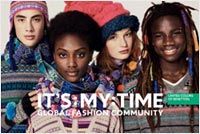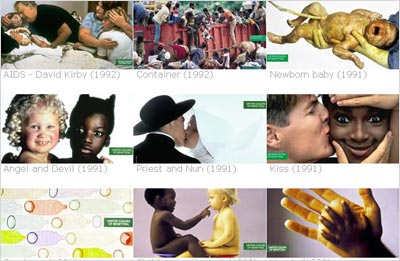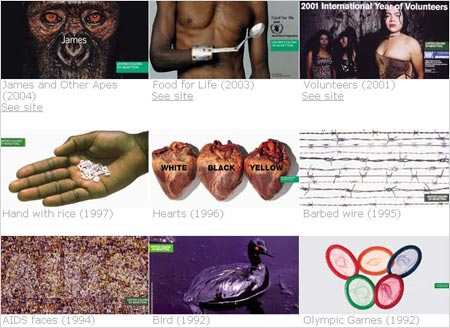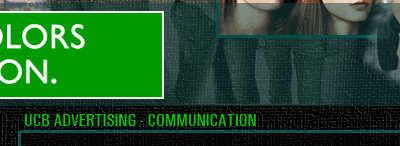The advertising philosophy of United Colors of Benetton is based on Luciano Benetton's belief that "communication should not be commissioned from outside the company, but conceived from within its heart." From that assumption stems the advertising strategy of a brand that has aimed, for over 20 years, to create "value" by capitalizing on an image.
A company that emphasizes value and chooses to create value is no longer communicating with the consumer but with the individual.
Actual consumption is repositioned within the overall context of life. By entering the universe of values, the brand frees the product from the world of merchandise and manufacturing and makes it a social being of its own. By addressing an individual rather than a customer, the brand can identify its target on the basis not of age or income, but of a shared vision of what is important, starting from a set of common values.

Since its origin as a fashion label for the young, Benetton has understood that putting resources into the building and promotion of its brand name was a sound strategic investment. The "united" colors of its sweaters soon became a metaphor for the united skin tones of the youth from many different countries for whom the sweaters were designed. As the markets expanded-Benetton became a global force in just a few years-the United Colors concept spread from encompassing the different races to the ideas of tolerance, peace and respect for diversity.
The company's brand evolved along with its technological progress. Benetton made its most incisive technical move in the early 60s, when it developed a procedure for the dyeing of finished garments rather than unwoven fibers. With this technique, the company could, right from its beginnings, react much more quickly to fashion trends, in a market where responsiveness is key. The manipulation of colors therefore became one of the hallmarks of Benetton's identity and industrial culture.
"All the colors of the world" was one of the first slogans to appear in Benetton ads, and was later altered to "United Colors of Benetton." The concept of united colors was such a strong one that for the first time in its history, the company adopted the slogan as its actual logo.
For the first time in the history of commercial trademarks, the slogan United Colors of Benetton became a trademark.
IT'S MY TIME
 From 8 February to 16 March 2010 Benetton launched its My Time, the first global interactive multimedia campaign: an online casting session to find the personal styles of young people and their vision of the future. The 20 winners have been shot in New York by British photographer Josh Ollins and are now featured in the United Colors of Benetton autumn-winter 2010/11 campaign worldwide. From 8 February to 16 March 2010 Benetton launched its My Time, the first global interactive multimedia campaign: an online casting session to find the personal styles of young people and their vision of the future. The 20 winners have been shot in New York by British photographer Josh Ollins and are now featured in the United Colors of Benetton autumn-winter 2010/11 campaign worldwide.
An expression of time

"Communication should never be commissioned from outside the company, but conceived from within its heart". Luciano Benetton
Benetton Group's advertising campaigns are not only a means of communication but an expression of their time. Through their universal impact, they have succeeded in attracting the attention of the public and in standing out amid the current clutter of images.
The campaigns have gathered awards and acclaim worldwide; by the same token, they have aroused strong reactions - at times ferocious, at times simply curious, confirming once again that they are always a focal point of discussion and of confrontation of ideas.
Several of the communication projects created by Fabrica, Benetton's research center have also been developed in cooperation with prestigious associations (including FAO, UNV, WFP) obtaining important acknowledgements at an international level.
United colors of Benetton
A trademark that became the driving force behind the "United Colors" message, which formed the basis of the advertising visuals designed to create a growing network of "United People." These images showed youth of both sexes and every skin tone who exuded integration, energy and joie de vivre. They suggested a somewhat abstract universe ruled by the easy straightforwardness of relationships and feelings.
At this point, the process of building value for the brand took place in three separate phases:
- The cycle of difference
- The cycle of reality
- The cycle of free speech and the right to express it
THE CYCLE OF DIFFERENCE

Benetton's long journey toward its destiny as a subverter of stereotypes began with its cooperation with Oliviero Toscani and the images of the 1986 campaign. Happy groups of multiracial kids were replaced by "couples" representing an all-new interpretation of difference. In this cycle, the word "different" became a close cousin of "controversial." Benetton learned that dealing with the issue of difference within the process of advertising is not an easy task. Often, an attempt to bring different individuals together can lead to conflict instead of happiness and euphoria.
Many ads from the period were an expression of this process. One represented religious and political conflict (the Palestinian and the Israeli):
Another depicted religious and sexual conflict (a priest kissing a nun), and yet another portrayed moral conflict (the stereotypes of good and evil, symbolized by an angel and the devil):
All of these conflicts were based on taboos, on the impossibility of co-existence, on a difference that separates rather than unites. By acknowledging these differences and prohibitions, the brand appeared more involved. It took sides, rather than presenting a simple "objective" portrayal of the world; it made a commitment to foster the cohabitation of opposites, to break down barriers and ensure dialogue. Benetton had a plan: to integrate opposites, to unite differences under a single flag, the flag of its own logo. In this phase, the "product" gradually disappeared from the advertisements. Traditional advertising messages made the product their obvious focus, so that the campaign would have a measurable commercial impact. Benetton took another path, wagering that once the brand's identity had been established, the product would become one of its attributes. The company was now taking hold on all the continents. Paradoxically, the growing popularity and availability of tangible Benetton merchandise-the goods people could buy in more than 5,000 stores worldwide-translated into the disappearance of those goods from its ads.
THE CYCLE OF REALITY
 After equality and the exaltation of differences, Benetton turned to the reality of what is common to all and shared by humankind. The dialogue that Benetton had begun with its "consumers" (whom it had always viewed, above all, as men and women) gained depth. After equality and the exaltation of differences, Benetton turned to the reality of what is common to all and shared by humankind. The dialogue that Benetton had begun with its "consumers" (whom it had always viewed, above all, as men and women) gained depth.
In 1991, during the Gulf War, this image was created, a photo of a war cemetery:
Published in just one newspaper in Italy, Il Sole 24 Ore, because all the others refused to print it, this photo signaled a break with the previous campaigns. The style became "realistic," introducing depth of field, and a bit of "real life" burst into the artificially sweetened universe of advertising. This unique photo prompted hundreds of articles all over the world. To opposition against the irruption of "death" as an advertising subject, Benetton answered with a birth, the famous image of a newborn baby still attached to the umbilical cord.
The photo of the newborn baby girl, Giusy, was intended as an anthem to life, but was one of the most censured visuals in the history of Benetton ads. In the realm of advertising, traditionally occupied by pretense, the eruption of real life caused a scandal.
In Italy, the protests started in Palermo, where the Town Council ordered Benetton to take down its advertising posters. In Milan, censorship was preventive and the vast ‘Piazza Duomo' stayed off-limits. The ad was then condemned by the Code of Advertising Practice Court, the Self-Regulatory Committee for the sector, which decided that the photo "does not take account of public sensitivity". Similar criticisms were expressed in Great Britain, Ireland and France. The subsequent fate of this image is however quite extraordinary; after the period of rejection, it started to be understood and appreciated. It was awarded a prize by the Swiss ‘Société Générale d'Affichage' (General Poster Association) and the Sant'Orsola General Hospital in Bologna asked for permission to display the photo in its delivery room. This same photo was also put on show in The Netherlands as part of an exhibition dedicated to the iconography of maternity over the centuries, in the Boymans-van-Beuningen Museum in Rotterdam.
At this point, the language of Benetton communication changed radically. With the February '92 campaign came the scandal of planetary proportions. These ads showed news photos of real, high-drama situations: a man dying of AIDS, a soldier gripping a human thigh bone, a man assassinated by the Mafia, a car on fire, a ship being stormed by emigrants.
The photo of David Kirby in his room in the Ohio State University Hospital in May 1990, with his family at his bedside, was taken by Therese Frare and had already been printed as a black and white press photo in Life magazine in November 1990. It had already won the 1991 World Press Photo Award, but it was Benetton's use of it in its advertising that brought it to the attention of the world media and made people talk about dying of AIDS. To the extent that, as well as winning the European Art Director Club award for the best 1991 campaign, the Houston International Center of Photography's Infinity Award and being exhibited in American, French, Italian, Swiss and German museums, in 2003 the photo was included in the Life magazine collection ‘100 Photos that changed the world'. David's parents, Bill and his wife Kay, took part in the press conference called by Benetton in the New York Public Library and while the world's opinion of this image remained split between accusations of cynicism and approval, and many magazines had already refused to print it, David's mother said: "We don't feel we've been used by Benetton, but rather the reverse: David is speaking much louder now that he's dead, than he did when he was alive."
The photos of the AIDS patient, the soldier and the Albanian emigrants were not taken for the ad campaign but were actual agency photos, in typical reportage style, used for conveying the news. These were photos that portrayed the "real" world, fell within the conventions of information, and introduced a new and intriguing question about the fate of advertising: can marketing and the enormous power of advertising budgets be used to establish a dialogue with consumers that focus on something other than a company's products? Where was it written that advertising could only portray the absence of conflict and pain?
THE CYCLE OF FREE SPEECH AND THE RIGHT TO EXPRESS IT
The reaction to these real-life photos was sometimes violent. Many publications in several countries refused to print the campaign. By eliminating the product from its ads, violating the taboo of disagreeable themes, associating its name with the representation of conflict and pain and, above all, abandoning the false, comfortable world of advertising stereotypes, Benetton cracked the foundation that held up the culture, language and specificity of the classic advertising message. Many complaints pointed to the "shock value" of the Benetton ads. But that argument did not hold water. The media have long inured us to all sorts of images: murders, natural catastrophes, genocide. The list of horrors and suffering that have been filtered through the media is, unfortunately, endless. In Benetton's case, then, what bothered people could not be the visuals in themselves but the fact that they were being used as advertising by a corporation? Other critics tolerated and even applauded Benetton's effort to raise public awareness about AIDS, war, racism, and so forth. But they found it wholly unacceptable that such an effort was also a source of income, a component of a profit-making venture. The profits, they said, turned protest into speculation, public message into cynicism. Nor did this argument hold up. In Western societies there are institutions and professions that are geared toward the public welfare (hospitals, doctors, police, firefighters, non-governmental organizations and government agencies), but that also earn money or make profits. For some reason, the practice is suddenly seen as disgraceful when it is a fashion label trying to establish a publicly useful debate, as on the topic of AIDS prevention. Here lies the essence of the scandal. Benetton was accused not of having exercised free speech, but of not being in a legitimate position to do so. As long as the company stuck to images from its "possible" world, there were no complaints at all. What upset people is that Benetton confused the possible world with the real one, on the assumption that it had the same right to talk about a world it had not created. However, the subsequent "legitimization" of the brand through the collaboration with numerous internationally renowned associations overcame this final objection.
In 1993, with the cooperation of the Swiss Caritas organization and the Red Cross International Federation in Geneva, Benetton launched its "Clothing Redistribution Project", the first worldwide operation aimed at the redistribution of clothing to needy people. The "star" of the ad was Luciano Benetton himself, significantly nude, covered only by the headline "Give me my clothes back", used as a "teaser", followed by "Empty your wardrobes". The true success of the campaign was however the 460,000 kg of used clothing collected by the 44 associations which, working with Caritas and the Red Cross, made it possible to achieve far-reaching redistribution throughout the world (the associations included the Buddhist Relief Old Clothes Help in Taiwan, the Global Jewish Assistance and Relief Network in Hong Kong, the Japan Relief Clothing Center in Tokyo, Gifts in Kind in the United States and Canada, the World Assembly of Muslim Youth in Arab Countries and Hogar de Cristo in Latin America).
For the sixth World AIDS Day, on December 1st 1993, an enormous pink condom, 22 meters high and 3.5 meters wide, was placed on the obelisk in the Place de la Concorde in Paris. This time, the stunt was endorsed by ACT UP, one of the most radical associations involved in information about and the fight against AIDS.
All the news programs on the main international television networks and, obviously, all the daily and magazine press featured the image that has become a symbol of the fight against AIDS.
Through its alliance with non-profit associations, institutions, and large international organisms, Benetton proved that a "different" use of advertising was indeed possible.
This different approach to communication, seen as the creation of value, has also expressed itself in the production of catalogues and fashion collections:
Always photographed with "real people", sometimes produced in cooperation with important publications (Enemies with Newsweek, for example, to give editorial backing to the message of peace contained in a simple commercial catalogue) or with educational establishments (such as the St. Valentin Institute, for young disabled people, based in Ruhpolding in the Bavarian Alps) or with the young inhabitants wanting to liberate a Sicilian town, Corleone, from the shadow of the "mafia", or even the urban ‘tribes' in a fashionable area of Tokyo.
The last campaign with Toscani, photographed in 2000 in a number of American jails, focused on the death penalty and was to have a sensational impact in the media. The main TV stations throughout the world devoted part of their news programs to the subject. The photos of the condemned prisoners were printed in all the international press while the debate on the death penalty was enriched with new and significant contributions. From 2000, Oliviero Toscani handed over responsibility for creativity to Fabrica, the communication research center which he himself helped to establish. Since 2001, the brand has alternated, every three seasons, conventional product campaigns with increasingly wide-ranging institutional campaigns.
The most recent include:
2001, Volunteers in Colors: a Benetton communication campaign, a special issue of COLORS and a concert, in collaboration with UN Volunteers to celebrate the International Year of Voluntary Work.
With this campaign, Benetton tackled a theme typical of its advertising and spoke, once again, about "real people", touching on society's real problems.
Voluntary work was depicted not as it usually is, associated with emergencies and pain, but rather as a way of finding fulfillment in helping others, a personal choice and a way of enriching one's own life.
2003, Food For Life: a Benetton communication campaign, a book and a COLORS supplement in collaboration with the World Food Programme, a front-line UN agency in the fight against world famine.
The campaign highlighted the problem of hunger, which is still the greatest humanitarian emergency around the world even though it has, to all intents and purposes, been forgotten by the media and the general public. The aim was to show how food can be a catalyst for social change, a major engine for peace and development that can radically change an individual's future prospects of life.
The campaign highlighted the problem of hunger, which is still the greatest humanitarian emergency around the world even though it has, to all intents and purposes, been forgotten by the media and the general public. The aim was to show how food can be a catalyst for social change, a major engine for peace and development that can radically change an individual's future prospects of life.
2008, Africa Works: a global communication campaign in favour of micro-credit in Senegal.
Benetton put the spotlight on entrepreneurial Africa. A global communication campaign promoting the Birima micro-credit programme in Senegal, a co-operative credit society founded by the Senegalese singer Youssou N'Dour. The programme received financial support from Benetton Group.
Benetton chose to support and promote this important project because, unlike traditional acts of solidarity, it offers tangible support to small local entrepreneurs through the efficient use of micro-credit. Precisely because it is based on entrepreneurial talent, hard work, optimism and interest for the future, this project effectively promotes the new face of Africa.
In addition to outdoor and press advertising, the Benetton campaign, included a series of projects and events: a COLORS supplement on micro-credit, a new version of Birima song by Youssou N'Dour with the extraordinary participation of Patti Smith, Simphiwe Dana, Irene Grandi and Francesco Renga; a videoclip of the song; a cartoon about micro-credit produced specifically for the Senegalese community and African TV channels, a Benetton website devoted to the campaign and its related events and the www.birima.org portal, both devised and developed by Fabrica.
The endorsement of these prestigious and irreproachable institutions marked the beginning of Benetton's current phase of communication, which continues to surprise us for its ability to forge bonds, to proliferate communication in a process of building information and awareness about social issues that involves a wide range of media players. The United Nations, SOS Racisme, associations fighting AIDS and the death penalty, pacifist groups, the U.N. High Commission for Refugees (UNHCR), and many volunteer associations now take advantage of the power and fame of the Benetton logo to communicate about issues they take to heart but for which they would never have had adequate budgets. The old charge that "Benetton exploits pain to sell sweaters" has been turned on its head. It is the U.N. and humanitarian groups that are taking advantage of the power and recognizabilty of the Benetton logo and its sweaters to give voice to the "rest of the world." This puts the logo at the threshold of a new, more advanced phase of value creation. Benetton is still talking about consumption and communications. The company has neither the desire nor, of course, the means to solve the world's problems. The label is geared not to a specific target but to a collective one: well heeled shoppers whom Benetton considers intellectually sophisticated enough to stop assailing them with "buy now"-type advertisements.
The "heart" of the company, from which communication is now born, is Fabrica, a true workshop for research, which is open to youngsters under 25 from all over the world. Fabrica's challenge is that of innovation and internationality: a way of combining culture and industry, through experimentation with new languages: in design, in graphics, on the web, in videos and the cinema, in music, in publishing and in photography. In this way, the Group pursues its strategy of creating value and contributes towards the uniqueness of a brand that has never stopped believing in research and experimentation.
|








